
Installation Instructions
Original Instructions
POINT I/O Source Input Modules
Catalog Numbers
1734-IV2,1734-IV4, 1734-IV8, 1734-IV8K, Series C
Catalog numbers with the suffix ‘K’ are conformal coated and their
specifications are the same as non-conformal coated catalogs.
Topic Page
Important User Information 2
Environment and Enclosure 3
North American Hazardous Location Approval 4
European Hazardous Location Approval 5
Special Conditions for Safe Use 7
Before You Begin 8
Install the Mounting Base 9
Install the Module 10
Install the Removable Terminal Block 11
Remove a Mounting Base 13
Wire the Module 14
Communicate with the Module 19
Interpret Status Indicators 20
Specifications 22

2 Rockwell Automation Publication 1734-IN052F-EN-E - January 2019
POINT I/O Source Input Modules
Important User Information
Solid-state equipment has operational characteristics differing from those of electromechanical
equipment. Safety Guidelines for the Application, Installation and Maintenance of Solid-state Controls
(Publication SGI-1.1
available from your local Rockwell Automation sales office or online at
http://www.rockwellautomation.com/literature/
) describes some important differences between solid-
state equipment and hard-wired electromechanical devices. Because of this difference, and also because of
the wide variety of uses for solid-state equipment, all persons responsible for applying this equipment
must satisfy themselves that each intended application of this equipment is acceptable.
In no event will Rockwell Automation, Inc. be responsible or liable for indirect or consequential damages
resulting from the use or application of this equipment.
The examples and diagrams in this manual are included solely for illustrative purposes. Because of the
many variables and requirements that are associated with any particular installation, Rockwell
Automation, Inc. cannot assume responsibility or liability for actual use based on the examples
and diagrams.
No patent liability is assumed by Rockwell Automation, Inc. with respect to use of information, circuits,
equipment, or software described in this manual.
Reproduction of the contents of this manual, in whole or in part, without written permission of
Rockwell Automation, Inc., is prohibited.
Throughout this manual, when necessary, we use notes to make you aware of safety considerations.
WARNING: Identifies information about practices or circumstances that can cause an
explosion in a hazardous environment, which may lead to personal injury or death, property
damage, or economic loss.
ATTENTION: Identifies information about practices or circumstances that can lead to
personal injury or death, property damage, or economic loss. Attentions help you identify a
hazard, avoid a hazard and recognize the consequences.
SHOCK HAZARD: Labels may be on or inside the equipment (for example, drive or motor)
to alert people that dangerous voltage may be present.
BURN HAZARD: Labels may be on or inside the equipment (for example, drive or motor) to
alert people that surfaces may reach dangerous temperatures.
IMPORTANT
Identifies information that is critical for successful application and understanding of
the product.

Rockwell Automation Publication 1734-IN052F-EN-E - January 2019 3
POINT I/O Source Input Modules
Environment and Enclosure
ATTENTION:
This equipment is intended for use in a Pollution Degree 2 industrial
environment, in overvoltage Category II applications (as defined in EN/IEC 60664-1),
at altitudes up to 2000 m (6562 ft) without derating.
This equipment is not intended for use in residential environments and may not
provide adequate protection to radio communication services in such environments.
This equipment is supplied as open-type equipment for indoor use. It must be
mounted within an enclosure that is suitably designed for those specific
environmental conditions that will be present and appropriately designed to
prevent personal injury resulting from accessibility to live parts. The enclosure
must have suitable flame-retardant properties to prevent or minimize the spread
of flame, complying with a flame spread rating of 5V A or be approved for the
application if nonmetallic. The interior of the enclosure must be accessible only by
the use of a tool. Subsequent sections of this publication may contain more
information regarding specific enclosure type ratings that are required to comply
with certain product safety certifications.
In addition to this publication, see the following:
• Industrial Automation Wiring and Grounding Guidelines,
publication 1770-4.1
, for additional installation requirements.
• NEMA Standard 250 and EN/IEC 60529, as applicable, for explanations of the
degrees of protection provided by enclosures.
ATTENTION: Read this document and the documents listed in the Additional
Resources section about installation, configuration, and operation of this
equipment before you install, configure, operate, or maintain this product. Users
are required to familiarize themselves with installation and wiring instructions in
addition to requirements of all applicable codes, laws, and standards.
Installation, adjustments, putting into service, use, assembly, disassembly, and
maintenance are required to be carried out by suitably trained personnel in
accordance with applicable code of practice. In case of malfunction or damage, no
attempts at repair should be made. The module should be returned to the
manufacturer for repair. Do not dismantle the module.

4 Rockwell Automation Publication 1734-IN052F-EN-E - January 2019
POINT I/O Source Input Modules
North American Hazardous Location Approval
The Following Information Applies When
Operating This Equipment In Hazardous Locations.
Informations sur l’utilisation de cet équipement en
environnements dangereux.
Products marked "CL I, DIV 2, GP A, B, C, D" are suitable
for use in Class I Division 2 Groups A, B, C, D, Hazardous
Locations and nonhazardous locations only. Each product
is supplied with markings on the rating nameplate
indicating the hazardous location temperature code.
When combining products within a system, the most
adverse temperature code (lowest "T" number) may be
used to help determine the overall temperature code of
the system. Combinations of equipment in your system
are subject to investigation by the local Authority Having
Jurisdiction at the time of installation.
Les produits marqués "CL I, DIV 2, GP A, B, C, D" ne
conviennent qu'à une utilisation en environnements de Classe
I Division 2 Groupes A, B, C, D dangereux et non dangereux.
Chaque produit est livré avec des marquages sur sa plaque
d'identification qui indiquent le code de température pour les
environnements dangereux. Lorsque plusieurs produits sont
combinés dans un système, le code de température le plus
défavorable (code de température le plus faible) peut être
utilisé pour déterminer le code de température global du
système. Les combinaisons d'équipements dans le système
sont sujettes à inspection par les autorités locales qualifiées
au moment de l'installation.
WARNING:
Explosion Hazard –
• Do not disconnect equipment
unless power has been removed
or the area is known to
be nonhazardous.
• Do not disconnect connections to
this equipment unless power has
been removed or the area is
known to be nonhazardous.
Secure any external connections
that mate to this equipment by
using screws, sliding latches,
threaded connectors, or other
means provided with this product.
• Substitution of components may
impair suitability for Class I,
Division 2.
AVERTISSEMENT:
Risque d’Explosion –
• Couper le courant ou s'assurer que
l'environnement est classé non
dangereux avant de débrancher
l'équipement.
• Couper le courant ou s'assurer que
l'environnement est classé non
dangereux avant de débrancher les
connecteurs. Fixer tous les connecteurs
externes reliés à cet équipement à
l'aide de vis, loquets coulissants,
connecteurs filetés ou autres moyens
fournis avec ce produit.
• La substitution de composants peut
rendre cet équipement inadapté à une
utilisation en environnement de
Classe I, Division 2.
WARNING: When used in a Class I, Division 2, hazardous location, this equipment
must be mounted in a suitable enclosure with proper wiring method that
complies with the governing electrical codes.

Rockwell Automation Publication 1734-IN052F-EN-E - January 2019 5
POINT I/O Source Input Modules
European Hazardous Location Approval
The following applies to products marked
• Are intended for use in potentially explosive atmospheres as defined by European Union
Directive 2014/34/EU and has been found to comply with the Essential Health and Safety
Requirements relating to the design and construction of Category 3 equipment intended for
use in Zone 2 potentially explosive atmospheres, given in Annex II to this Directive.
• Compliance with the Essential Health and Safety Requirements has been assured by
compliance with EN 60079-15 and EN 60079-0.
• Are Equipment Group II, Equipment Category 3, and comply with the Essential Health and
Safety Requirements relating to the design and construction of such equipment given in
Annex II to Directive 2014/34/EU. See the EC Declaration of Conformity at
http://www.rockwellautomation.com/global/certification/overview.page
for details.
• The type of protection is II 3G Ex nA IIC T4 Gc according to EN 60079-15.
• Comply to Standards EN 60079-0:2012, EN 60079-15:2010, reference certificate number
DEMKO04ATEX0330347X.
• Are intended for use in areas in which explosive atmospheres caused by gases, vapors, mists,
or air are unlikely to occur, or are likely to occur only infrequently and for short periods. Such
locations correspond to Zone 2 classification according to ATEX directive 2014/34/EU.
• May have catalog numbers followed by a “K” to indicate a conformal coating option.

6 Rockwell Automation Publication 1734-IN052F-EN-E - January 2019
POINT I/O Source Input Modules
Prevent Electrostatic Discharge
WARNING:
• This equipment is not resistant to sunlight or other sources of UV radiation.
• This equipment shall be mounted in an ATEX/IECEx Zone 2 certified enclosure
with a minimum ingress protection rating of at least IP54 (in accordance with
EN/IEC 60079-15) and used in an environment of not more than Pollution
Degree 2 (as defined in EN/IEC 60664-1) when applied in Zone 2
environments. The enclosure must be accessible only by the use of a tool.
• This equipment shall be used within its specified ratings defined by
Rockwell Automation.
• Provision shall be made to prevent the rated voltage from being exceeded by
transient disturbances of more than 140% of the peak rated voltage when
applied in Zone 2 environments.
• The instructions in the user manual shall be observed.
• This equipment must be used only with ATEX certified
Rockwell Automation backplanes.
• Earthing is accomplished through mounting of modules on rail.
• Devices shall be used in an environment of not more than Pollution Degree 2.
ATTENTION: This equipment is sensitive to electrostatic discharge, which can
cause internal damage and affect normal operation. Follow these guidelines
when you handle this equipment:
• Touch a grounded object to discharge potential static.
• Wear an approved grounding wriststrap.
• Do not touch connectors or pins on component boards.
• Do not touch circuit components inside the equipment.
• Use a static-safe workstation, if available.
• Store the equipment in appropriate static-safe packaging when not in use.

Rockwell Automation Publication 1734-IN052F-EN-E - January 2019 7
POINT I/O Source Input Modules
Special Conditions for Safe Use
Electrical Safety Considerations
ATTENTION:
• This product is grounded through the DIN rail to chassis ground. Use zinc-
plated chromate-passivated steel DIN rail to assure proper grounding. The use
of other DIN rail materials (for example, aluminum or plastic) that can corrode,
oxidize, or are poor conductors, can result in improper or intermittent
grounding. Secure DIN rail to mounting surface approximately every 200 mm
(7.8 in.) and use end-anchors appropriately. Be sure to ground the DIN rail
properly. Refer to Industrial Automation Wiring and Grounding Guidelines,
publication 1770-4.1, for more information.
• Do not remove or replace an Adapter Module while power is applied.
Interruption of the backplane can result in unintentional operation or
machine motion.
• Do not discard the end cap. Use this end cap to cover the exposed
interconnections on the last mounting base on the DIN rail. Failure to do so
could result in equipment damage or injury from electric shock.
• If this equipment is used in a manner not specified by the manufacturer, the
protection provided by the equipment may be impaired.
ATTENTION:
• This equipment is certified for use only within the surrounding air temperature
range of -20…+55 °C (-4…+131 °F). The equipment must not be used
outside of this range.
• Use only a soft dry anti-static cloth to wipe down equipment. Do not use any
cleaning agents.
At the end of its life, this equipment should be collected separately from any
unsorted municipal waste.

8 Rockwell Automation Publication 1734-IN052F-EN-E - January 2019
POINT I/O Source Input Modules
Before You Begin
You can use these Series C POINT I/O™ Input modules with DeviceNet and
PROFIBUS adapters. If you are using RSLogix 5000® software, version 11 or
higher, you can also use the modules with ControlNet and Ethernet adapters.
Use this diagram to identify the external features of the module.
POINT I/O™ Input Module with 1734-TB or 1734-TBS Base
Module
Status
N
et
w
o
r
k
S
t
at
u
s
N
ODE
:
0
1
2
3
1
10
9
8
7
2
4
5
6
3
The wiring base assembly includes terminal
base, 1734-TB, or 1734-TBS, which consists of a
mounting base, 1734-MB, and removable
terminal block, 1734-RTB, or 1734-RTBS.

Rockwell Automation Publication 1734-IN052F-EN-E - January 2019 9
POINT I/O Source Input Modules
Install the Mounting Base
To install the mounting base on the DIN rail, proceed as follows:
1. Position the mounting base vertically above the installed units (adapter,
power supply, or existing module).
2. Slide the mounting base down allowing the interlocking side pieces to
engage the adjacent module or adapter.
3. Press firmly to seat the mounting base on the DIN rail. The mounting
base snaps into place. Be sure that the orange DIN rail locking screw is in
the horizontal position and that it has engaged the DIN rail.
Description Description
1 Module locking mechanism 6 1734-TB or 1734-TBS mounting base
2 Slide-in writable label 7 Interlocking side pieces
3 Insertable I/O module 8 Mechanical keying (orange)
4 Removable terminal block (RTB) handle 9 DIN rail locking screw (orange)
5
Removable terminal block with screw (1734-
RTB) or spring clamp (1734-RTBS)
10 Module wiring diagram

10 Rockwell Automation Publication 1734-IN052F-EN-E - January 2019
POINT I/O Source Input Modules
Install the Module
The module can be installed before or after base installation. Make sure that the
mounting base is correctly keyed before installing the module into the mounting
base. In addition, make sure that the mounting base locking screw is positioned
horizontal referenced to the base.
1. Using a bladed screwdriver, rotate the keyswitch on the mounting base
clockwise until the number required for the type of module being
installed aligns with the notch in the base.
2. Verify that the DIN rail locking screw is in the horizontal position. You
cannot insert the module if the locking mechanism is unlocked.
3. Insert the module straight down into the mounting base.
4. Press to secure. The module locks into place.
ATTENTION: When you insert or remove the module while backplane power is
on, an electrical arc can occur. This could cause an explosion in hazardous
location installations.
Be sure that power is removed or the area is non-hazardous before proceeding.
Repeated electrical arcing causes excessive wear to contacts on both the module
and its mating connector. Worn contacts may create electrical resistance that can
affect module operation.
ATTENTION: Do not discard the end cap. Use this end cap to cover the exposed
interconnections on the last mounting base on the DIN rail. Failure to do so could
result in equipment damage or injury from electric shock.

Rockwell Automation Publication 1734-IN052F-EN-E - January 2019 11
POINT I/O Source Input Modules
Install the Removable Terminal Block
A Removable Terminal Block (RTB) is supplied with your wiring base assembly.
To remove, pull up on the RTB handle. This allows the mounting base to be
removed and replaced as necessary without removing any of the wirings. To
reinsert the Removable Terminal Block, proceed as follows.
1. Insert the end opposite the handle into the base unit.
This end has a curved section that engages with the wiring base.
2. Rotate the terminal block into the wiring base until it locks itself
in place.
3. If an I/O module is installed, snap the RTB handle into place on
the module.
WARNING: When you connect or disconnect the Removable Terminal Block (RTB)
with field-side power applied, an electrical arc can occur. This can cause an
explosion in hazardous location installations.
Be sure that power is removed or the area is nonhazardous before proceeding.
0
1
Hook the RTB end into the
mounting base end, and rotate
until it locks into place.
44012

12 Rockwell Automation Publication 1734-IN052F-EN-E - January 2019
POINT I/O Source Input Modules
WARNING: For 1734-RTBS and 1734-RTB3S, to latch and unlatch the wire, insert
a bladed screwdriver (catalog number 1492-N90 – 3 mm diameter blade) into
the opening at approximately 73° (blade surface is parallel with top surface of the
opening) and push up gently.
WARNING: For 1734-TOPS and 1734-TOP3S, to latch and unlatch the wire, insert
a bladed screwdriver (catalog number 1492-N90 – 3 mm diameter) into the
opening at approximately 97° (blade surface is parallel with top surface of the
opening) and press in (do not push up or down).
73°
85°
97°

Rockwell Automation Publication 1734-IN052F-EN-E - January 2019 13
POINT I/O Source Input Modules
Remove a Mounting Base
To remove a mounting base, you must remove any installed module and the
module that is installed in the base to the right. Remove the removable terminal
block, if wired.
1. Unlatch the RTB handle on the I/O module.
2. Pull on the RTB handle to remove the removable terminal block.
3. Press the module lock on the top of the module.
4. Pull on the I/O module to remove from the base.
5. Repeat steps 1, 2, 3 and 4 for the module to the right.
6. Use a small bladed screwdriver to rotate the orange base locking screw to
a vertical position. This releases the locking mechanism.
7. Lift straight up to remove.

14 Rockwell Automation Publication 1734-IN052F-EN-E - January 2019
POINT I/O Source Input Modules
Wire the Module
To wire the module, see the diagrams and tables.
WARNING: If you connect or disconnect wiring while the field-side power is on,
an electrical arc can occur. This could cause an explosion in hazardous location
installations. Be sure that power is removed or the area is nonhazardous
before proceeding.
nput 0
NC
C
NC
Input 1
C
VV
Input = 0 and 1
NC = No connection (2 and 3)
C = Common (4 and 5)
V = Supply (6 and7)
Input 0 Input 1
1734-IV2 1734-IV4 1734-IV8, 1734-IV8K
24VDC
Source
Input
Module
Status
Network
Status
1734
IV2
NODE:
0
1
24VDC
Source
Input
Module
Status
Network
Status
1734
IV4
NODE:
0
1
2
3
24VDC
Source
Input
Module
Status
Network
Status
1734
IV8
NODE:
0
1
2
3
4
5
6
7
Input 3
Input 5
Input 7
Input 2
Input 4
Input 6
Input 0 Input 1
Input 3Input 2
C
V
C
V
Input 0, 1, 2, and 3
C = Common (4 and 5)
V = Supply (6 and7)
Input 0, 1, 2, 3, 4, 5, 6, and 7
Note: V and C are daisy chained
from either the adapter, 1734-FPD,
1734-EP24DC, or from a user
supplied auxiliary terminal block.

Rockwell Automation Publication 1734-IN052F-EN-E - January 2019 15
POINT I/O Source Input Modules
POINT I/O Source Input Module Wiring – 1734-IV2
POINT I/O Source Input Module Wiring – 1734-IV4
Channel Input Terminal Common Terminal Power
0046
1157
Connect power on 3-wire proximity switches.
12/24V DC is provided by the internal field power bus.
Channel Input Terminal Common Terminal Power
0046
1157
2246
3357
Connect power on 3-wire proximity switches.
12/24V DC is provided by the internal field power bus.
In 0
10
32
54
76
In 1
NC
CC
VV
2-wire
C = Common
V = 12/24V DC supply
3-wire
NC
ProxProx
In 0
10
32
54
76
In 1
NC
CC
VV
2-wire
C = Common
V = 12/24V DC supply
3-wire
NC
Prox ProxProx Prox

16 Rockwell Automation Publication 1734-IN052F-EN-E - January 2019
POINT I/O Source Input Modules
POINT I/O Source Input Module Wiring – 1734-IV8, 1734-IV8K
Channel Input Terminal Channel Input Terminal
00 44
11 55
22 66
33 77
Daisy chain common and power connections from 1734 adapter, 1734-FPD, 1734-EP24DC, or from user
supplied external auxiliary terminal block.
In 0
10
32
54
76
In 1
2-wire
C = Common
V=12/24V DC supply
3-wire
In 2 In 3
In 4 In 5
In 6 In 7
Prox
Prox
Prox
Prox
2-wire
3-wire
CV
2-wire
3-wire
Prox
Prox
Prox
Prox
2-wire
3-wire
CV

Rockwell Automation Publication 1734-IN052F-EN-E - January 2019 17
POINT I/O Source Input Modules
Wiring Example of 1734-IV8, 1734-IV8K Using 2-Wire Proximity Switches
System
Power
DeviceNet
Power
Network
Status
Module
Status
1734
OB8E
3
2
0
1
7
6
4
5
Network
Status
Module
Status
1734
IV8
3
2
0
1
7
6
4
5
Prox
Prox
Prox
Prox
Prox
Prox
Prox
Prox
DeviceNet
24V DC return (C)
24V DC (V)
Terminal block with bus connector strip

18 Rockwell Automation Publication 1734-IN052F-EN-E - January 2019
POINT I/O Source Input Modules
Wiring Example of 1734-IV8, 1734-IV8K Using 3-Wire Proximity Switches
System
Power
DeviceNet
Power
Network
Status
Module
Status
1734
OB8E
3
2
0
1
7
6
4
5
Network
Status
Module
Status
1734
IV8
3
2
0
1
7
6
4
5
Prox
Prox
Prox
Prox
Prox
Prox
Prox
Prox
DeviceNet
24V DC return (C)
24V DC (V)
Terminal block with bus
connector strip
Terminal block with bus
connector strip

Rockwell Automation Publication 1734-IN052F-EN-E - January 2019 19
POINT I/O Source Input Modules
Communicate with the Module
POINT I/O modules send (produce) and receive (consume) I/O data (messages). You
map this data into the memory of the processor.
The 1734-IV2, 1734-IB4, and 1734-IV78 modules produce 1 byte of input data (scanner
Rx). The modules do not consume I/O data (scanner Tx).
Default Data Map for 1734-IV2
Message Size: 1 Byte
765 43210
Produces (Rx) I1 I0
Consumes (Tx) No consumed data
Where: I0 = Channel 0, I1 = Channel 1
Default Data Map for 1734-IV4
Message Size: 1 Byte
765 43210
Produces (Rx) I3 I2 I1 I0
Consumes (Tx) No consumed data
Where: I0 = Channel 0, I1 = Channel 1, I2 = Channel 2, I3 = Channel 3
Default Data Map for 1734-IV2
Message Size: 1 Byte
765 43210
Produces (Rx) I7 I6 I5 I4 I3 I2 I1 I0
Consumes (Tx) No consumed data
Where:
I0 = Channel 0, I1 = Channel 1, I2 = Channel 2, I3 = Channel 3,
I4 = Channel 4, I5 = Channel 5, I6 = Channel 6, I7 = Channel 7

20 Rockwell Automation Publication 1734-IN052F-EN-E - January 2019
POINT I/O Source Input Modules
Interpret Status Indicators
See the following diagram and table for information on how to interpret the
status indicators.
Module status
Network status
Status of input 0
Status of input 1
1734-IV2 1734-IV4
1734-IV8,
1734-IV8K
Status of input 2
24VDC
Source
Input
Module
Status
Network
Status
1734
IV2
NODE:
0
1
24VDC
Source
Input
Module
Status
Network
Status
1734
IV4
NODE:
0
1
2
3
24VDC
Source
Input
Module
Status
Network
Status
1734
IV8
NODE:
0
1
2
3
4
5
6
7
Status of input 0 and 4
Status of input 1 and 5
Status of input 2 and 6
Status of input 3 and 7Status of input 3
Module status
Network status
Page is loading ...
Page is loading ...
Page is loading ...
Page is loading ...
Page is loading ...
Page is loading ...
Page is loading ...
Page is loading ...
-
 1
1
-
 2
2
-
 3
3
-
 4
4
-
 5
5
-
 6
6
-
 7
7
-
 8
8
-
 9
9
-
 10
10
-
 11
11
-
 12
12
-
 13
13
-
 14
14
-
 15
15
-
 16
16
-
 17
17
-
 18
18
-
 19
19
-
 20
20
-
 21
21
-
 22
22
-
 23
23
-
 24
24
-
 25
25
-
 26
26
-
 27
27
-
 28
28
Allen-Bradley POINT I/O 1734-IV8 Installation Instructions Manual
- Type
- Installation Instructions Manual
- This manual is also suitable for
Ask a question and I''ll find the answer in the document
Finding information in a document is now easier with AI
Related papers
-
Allen-Bradley 1734D-IB16 User manual
-
Allen-Bradley POINT I/O 1734-OB2EP Installation Instructions Manual
-
Allen-Bradley 1734-OE4C Installation Instructions Manual
-
Allen-Bradley POINT I/O 1734-OB8K Installation Instructions Manual
-
Allen-Bradley POINT I/O 1734-VHSC24 Installation Instructions Manual
-
Allen-Bradley POINT I/O 1734-VHSC24 Installation Instructions Manual
-
Allen-Bradley POINT I/O 1734-IB4D Installation Instructions Manual
-
Allen-Bradley POINT I/O 1734-PDN Installation Instructions Manual
-
Allen-Bradley 1734-IB8 Installation Instructions Manual
-
Allen-Bradley Rockwell Automation 1734-AENT Installation Instructions Manual
Other documents
-
 Rockwell Automation POINT I/O Installation Instructions Manual
Rockwell Automation POINT I/O Installation Instructions Manual
-
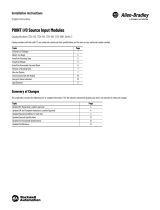 Allen Bradley Allen-Bradley 1734-IV2 POINT I-O Source Input Modules User manual
Allen Bradley Allen-Bradley 1734-IV2 POINT I-O Source Input Modules User manual
-
 Rockwell Automation 1734-OE4C Installation Instructions Manual
Rockwell Automation 1734-OE4C Installation Instructions Manual
-
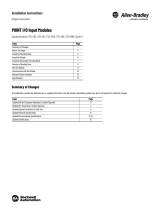 Allen Bradley Allen-Bradley 1734-IB2 POINT I/O Input Modules User manual
Allen Bradley Allen-Bradley 1734-IB2 POINT I/O Input Modules User manual
-
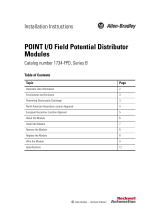 Rockwell Automation Allen-Bradley POINT I/O 1734-FPD Installation Instructions Manual
Rockwell Automation Allen-Bradley POINT I/O 1734-FPD Installation Instructions Manual
-
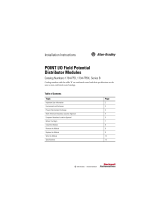 Rockwell Automation Allen-Bradley POINT I/O B Series Installation Instructions Manual
Rockwell Automation Allen-Bradley POINT I/O B Series Installation Instructions Manual
-
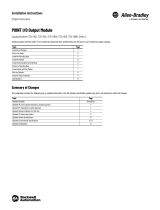 Allen Bradley Allen-Bradley 1734-OB2 POINT I/O Output Module User manual
Allen Bradley Allen-Bradley 1734-OB2 POINT I/O Output Module User manual
-
 Rockwell Automation 1734-IA2 Installation Instructions Manual
Rockwell Automation 1734-IA2 Installation Instructions Manual
-
 Rockwell Automation 1734-VHSC5 Installation Instructions Manual
Rockwell Automation 1734-VHSC5 Installation Instructions Manual
-
Spectrum Controls 1734sc-IF4U Owner's manual




































